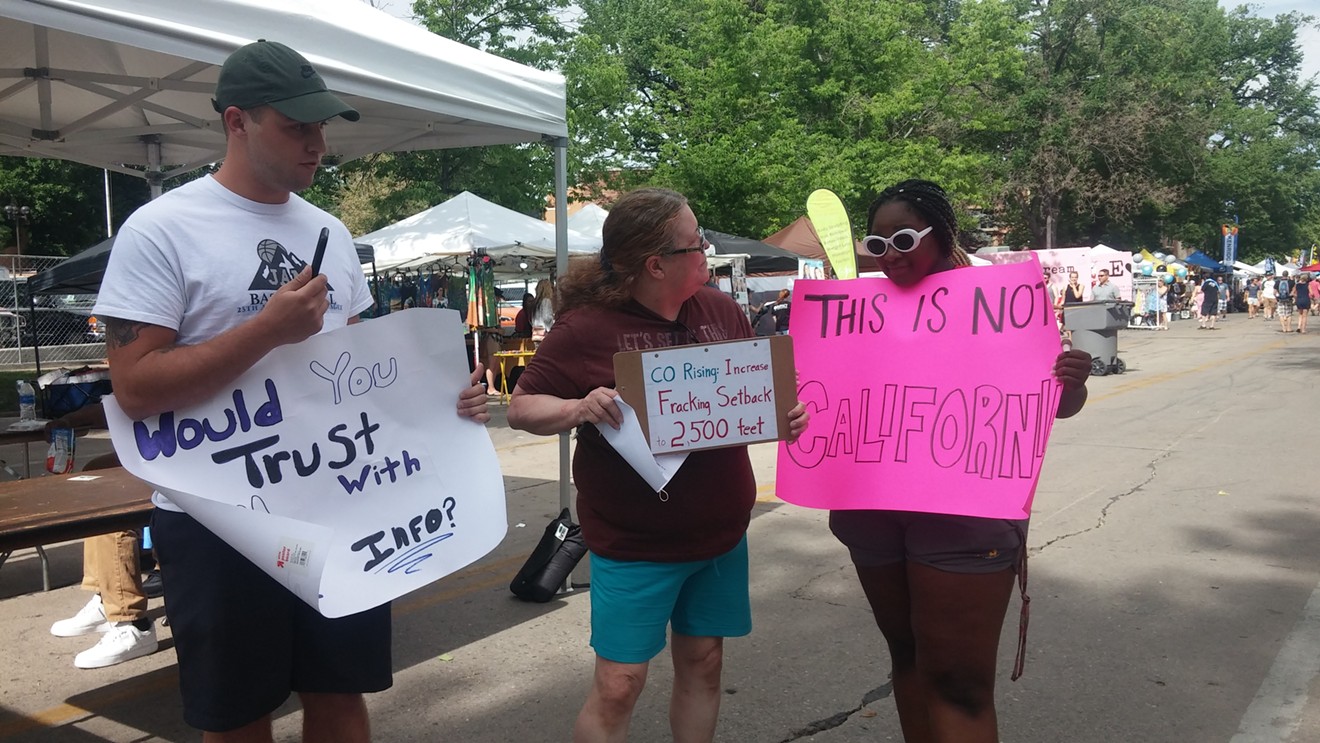And the interests countering Initiative 97 might have more ammunition to work with after a new study shows that the proposed ballot measure would spell doom for the industry.
The Colorado Oil and Gas Conservation Commission, the state regulatory agency that conducted the study, estimates that 85 percent of non-federal land in Colorado would be off limits to new development. That's because any new development — exploration, drilling, production or processing and treatment of hydrocarbons as well as flowlines — must be 2,500 feet away from occupied buildings and so-called vulnerable areas, including playgrounds, sports fields, amphitheaters, public open space, open bodies of water and drinking water sources. (Federal lands, which make up 36 percent of the state, are exempt from the 2,500-foot setback. When factoring in federal land, the agency estimates that new development would be banned in 54 percent of the state.)
“Clearly this is an attempt to stop energy development in our state, and this impact statement proves it. This is bad for Colorado all the way around," said Tracee Bentley, Colorado Petroleum Council's executive director, in a statement.
Nearly 80 percent of Weld County alone, which is central to the state's oil economy, would be off limits to new development (Weld's Wattenberg Field is one of the top ten producing oil and gas fields in the country).
The study also maps out the future of fracking in Colorado. Most of the frack-free zones would be concentrated along the Front Range and eastern plains, primarily because of the high concentration of federally owned land on the Western Slope and in the southwest corner of the state. The COGCC map below outlines development-free zones — the streaks of cyan and yellow — if Initiative 97 is approved in November. Only federal lands, which are the pink patches, and the areas in white, mostly remote areas of the eastern plains, will be open for development.

An excerpt from the COGCC's study on the potential impact of Initiative 97 on oil and gas developments in the state. The cyan and yellow patches mark areas where new development will be banned under a proposed 2,500-foot setback.
Colorado Oil and Gas Conservation Commission
Colorado Rising for Health and Safety, the group behind Initiative 97, is skeptical of the COGCC's study and its claims that the ballot measure would limit oil and gas activity in the state so severely.
"First of all, you have to recognize who this agency is. You have to remember that the agency itself has an agenda. This is an agency that has never, ever denied a single [oil and gas] permit in Colorado. It's the same agency that challenged the [Colorado Court of Appeals] Martinez decision, which stated the health and safety of Coloradans is a priority to the development of oil and gas. They challenged that decision. ... They think the growth of the industry is a priority," says Suzanne Spiegel, a Colorado Rising proponent and campaign director at Frack Free Colorado. "What we're doing is very simple. We're trying to put [in] 2,500-foot setbacks."
Colorado Rising for Health and Safety is in the signature-gathering phase to petition onto the ballot; signatures are due to the Colorado Secretary of State by August 6. The group doesn't want a repeat of 2016, when a nearly identical measure failed to make the ballot after an audit by the Secretary of State's Office determined that only 80,000 of the 107,000 signatures gathered by Safety Over Fracking were valid.
Though it's only required to turn in 98,492 valid signatures, Colorado Rising plans to gather at least 120,000 to pass an audit. (This year has been particularly tough for signature-gathering. Congressman Doug Lamborn was almost ousted from the Republican primary over his signature scandal, and Democratic attorney general candidate Brad Levin didn't make the primaries after his signature gatherers failed to follow the rules altogether.)Making its job even more difficult, Colorado Rising alleges that its signature-gatherers have been stalked by paid protesters, who allegedly intimidated voters into not signing petitions.
tweet this
Making its job even more difficult, Colorado Rising alleges that its signature-gatherers have been stalked by paid protesters, who allegedly intimidated voters into not signing petitions. The group says it intends to file criminal charges with district attorneys in Denver, Boulder, Weld and Larimer counties for election interference.
Colorado Rising is rallying support around Initiative 97 in the wake of more than a dozen oil- and gas-related explosions and leaks in the state since the Firestone explosion early last year, where two people were killed in their home after a cut flowline leaked a mix of methane and propane into the home.
Existing state regulations specify minimum setback requirements for oil and gas facilities at 350 feet for outdoor-activity areas like playgrounds, 500 feet for occupied buildings, and 1,000 feet for high-occupancy buildings like schools or hospitals. Those setbacks are measured from the center of the well to the buildings, not the property line. Some cities have tried to implement fracking moratoriums, but failed after a court ruled that state law preempts local ordinances. With lawmakers unwilling to pass new setback legislation and an ongoing Colorado Supreme Court case in which the state is suing to not make public health a pre-condition for drilling permits, direct democracy by ballot petition may be the only way voters can finally voice their opinion on the future of the oil and gas industry.
"Since the COGCC has failed to put public health and safety first and protect Colorado families from this toxic industrial activity, we the people must act to protect our homes from this clear and present danger," says Colorado Rising boardmember Micah Parkin.












